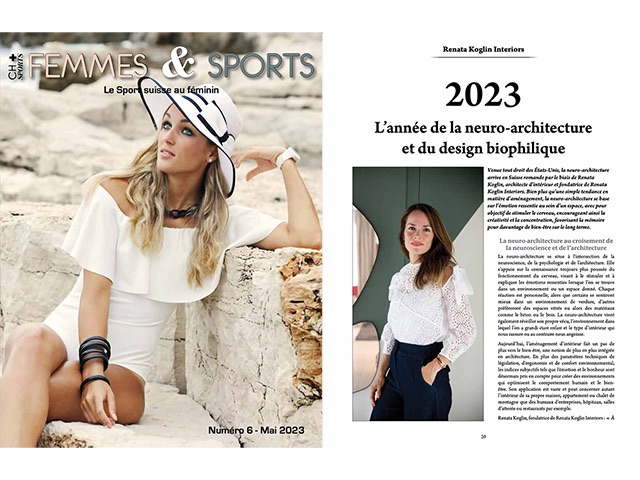Media
Femmes & Sports - The year of neuro-architecture and biophilic design
Coming straight from the United States, neuro-architecture arrives in French-speaking Switzerland through Renata Koglin, interior architect and founder of Renata Koglin Interiors. Much more than a simple trend in interior design, neuro-architecture is based on the emotion felt within a space, with the aim of stimulating the brain, thus encouraging creativity and concentration, favouring memory for greater well-being in the long term.
Femmes & Sports May 2023 edition
Neuro-architecture at the crossroads of neuroscience and architecture
Neuro-architecture is at the intersection of neuroscience, psychology and architecture. It is based on an ever-increasing knowledge of how the brain works, aiming to stimulate it and explain the emotions felt when one is in a given environment or space. Each reaction is personal, while some people will feel better in a green environment, others will prefer glazed spaces or materials like concrete or wood. Neuro-architecture also brings to mind one's own experiences, the environment in which one grew up as a child and the type of interior that reassures or, on the contrary, distresses us.
Today, interior design is taking another step towards well-being, a concept that is increasingly being integrated into architecture. In addition to the technical parameters of legislation, ergonomics and environmental comfort, subjective cues such as emotion and happiness are now taken into account to create environments that optimise human behaviour and well-being. Its application is wide-ranging and can be applied to the interior of one's own home, flat or mountain chalet as well as to corporate offices, hospitals, waiting rooms or restaurants, for example.
Renata Koglin, founder of Renata Koglin Interiors: "constantly looking for ways to positively impact people's lives, I decided to specialise in neuro-architecture and biophilic design. With a deeper understanding of how different sensory elements can impact people's emotions, my goal is to bring psychological balance and harmony to transform interiors, homes or offices and, as a result, change lives."
Biophilic design places nature at thethe heart of spaces
Biophilia is part of neuro-architecture and means the love of nature incorporated in environments with greenery and natural elements. Biophilic design aims to improve air quality and circulation, heart rate and overall well-being. Incorporating houseplants and natural patterns enhances the multi-sensory experience and stimulates visual connection. Natural materials, the presence of water and natural light are among the trends in biophilic design.
Renata Koglin, founder of Renata Koglin Interiors: "In Switzerland we spend a lot of time indoors because the cold season is long and dark. We lose our contact with nature, which is one of our basic needs. My aim is to provide interior design solutions that have a long-term impact on people's well-being. Neuro-architecture and biophilic design are not just a trend, they are now a fundamental reflection that architects must carry out, which I wish to anchor in French-speaking Switzerland, both in private and public environments.


